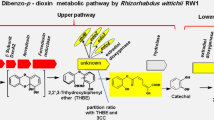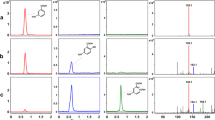Abstract
The first step in the degradation of 3-nitrotoluene by Diaphorobacter sp. strain DS2 is the dihydroxylation of the benzene ring with the concomitant removal of nitro group. This is catalyzed by a dioxygenase enzyme system. We report here the cloning and sequencing of the complete dioxygenase gene with its putative regulatory sequence from the genomic DNA of Diaphorobacter sp. strains DS1, DS2 and DS3. Analysis of the 5 kb DNA stretch that was cloned, revealed five complete open reading frames (ORFs) encoding for a reductase, a ferredoxin and two dioxygenase subunits with predicted molecular weights (MW) of 35, 12, 50 and 23 kDa respectively. A regulatory protein was also divergently transcribed from the reductase subunit and has a predicated MW of 34 kDa. Presence of parts of two functional ORFs in between the reductase and the ferredoxin subunits reveals an evolutionary route from a naphthalene dioxygenase like system of Ralstonia sp. strain U2. Further a 100 % identity of its ferredoxin subunit reveals its evolution via dinitrotoluene dioxygenase like system present in Burkholderia cepacia strain R34. A modeled structure of oxygenase3NT from strain DS2 was generated using nitrobenzene dioxygenase as a template. The modeled structure only showed minor changes at its active site. Comparison of growth patterns of strains DS1, DS2 and DS3 revealed that Diaphorobacter sp. strain DS1 has been evolved to degrade 4-nitrotoluene better by an oxidative route amongst all three strains.







Similar content being viewed by others
References
Altschul SF, Gish W, Miller W, Myers EW, Lipman DJ (1990) Basic local alignment search tool. J Mol Biol 215:403–410
Arora PK, Sasikala C, Ramana CV (2012) Degradation of chlorinated nitroaromatic compounds. Appl Microbiol Biotechnol 93:2265–2277
Booth G (2007) Aromatic nitro compounds. In: Joseph W, Doni G (eds) Ullmann’s encylcopedia of industrial chemistry. Wiley, New York, pp 1–47
Chadhain SM, Moritz EM, Kim E, Zylstra GJ (2007) Identification, cloning, and characterization of a multicomponent biphenyl dioxygenase from Sphingobium yanoikuyae B1. J Ind Microbiol Biotechnol 34:605–613
Copley SD (2009) Evolution of efficient pathways for degradation of anthropogenic chemicals. Nat Chem Biol 5:559–566
Davidson E, Ohnishi T, Atta-Asafo-Adjei E, Daldal F (1992) Potential ligands to the [2Fe–2S] Rieske cluster of the cytochrome bc1 complex of Rhodobacter capsulatus probed by site-directed mutagenesis. Biochemistry 31:3342–3351
Felsenstein J (1985) Confidence-limits on phylogenies—an approach using the bootstrap. Evolution 39:783–791
Ferraro DJ, Gakhar L, Ramaswamy S (2005) Rieske business: structure-function of Rieske non-heme oxygenases. Biochem Biophys Res Commun 338:175–190
Fuenmayor SL, Wild M, Boyes AL, Williams PA (1998) A gene cluster encoding steps in conversion of naphthalene to gentisate in Pseudomonas sp. strain U2. J Bacteriol 180:2522–2530
Gibson DT, Parales RE (2000) Aromatic hydrocarbon dioxygenases in environmental biotechnology. Curr Opin Biotechnol 11:236–243
Haigler BE, Spain JC (1993) Biodegradation of 4-nitrotoluene by Pseudomonas sp. strain 4NT. Appl Environ Microbiol 59:2239–2243
Haigler BE, Wallace WH, Spain JC (1994) Biodegradation of 2-nitrotoluene by Pseudomonas sp. strain JS42. Appl Environ Microbiol 60:3466–3469
Johnson GR, Jain RK, Spain JC (2002) Origins of the 2,4-dinitrotoluene pathway. J Bacteriol 184:4219–4232
Jones RM, Britt-Compton B, Williams PA (2003) The naphthalene catabolic (nag) genes of Ralstonia sp. strain U2 are an operon that is regulated by NagR, a LysR-type transcriptional regulator. J Bacteriol 185:5847–5853
Ju KS, Parales RE (2009) Application of nitroarene dioxygenases in the design of novel strains that degrade chloronitrobenzenes. Microb Biotechnol 2:241–252
Ju KS, Parales RE (2010) Nitroaromatic compounds, from synthesis to biodegradation. Microbiol Mol Biol R 74:250–272
Ju KS, Parales RE (2011) Evolution of a new bacterial pathway for 4-nitrotoluene degradation. Mol Microbiol 82:355–364
Ju KS, Parales JV, Parales RE (2009) Reconstructing the evolutionary history of nitrotoluene detection in the transcriptional regulator NtdR. Mol Microbiol 74:826–843
Kauppi B, Lee K, Carredano E, Parales RE, Gibson DT, Eklund H, Ramaswamy S (1998) Structure of an aromatic-ring-hydroxylating dioxygenase-naphthalene 1,2-dioxygenase. Structure 6:571–586
Keenan BG, Leungsakul T, Smets BF, Wood TK (2004) Saturation mutagenesis of Burkholderia cepacia R34 2,4-dinitrotoluene dioxygenase at DntAc valine 350 for synthesizing nitrohydroquinone, methylhydroquinone, and methoxyhydroquinone. Appl Environ Microbiol 70:3222–3231
Kivisaar M (2009) Degradation of nitroaromatic compounds: a model to study evolution of metabolic pathways. Mol Microbiol 74:777–781
Kivisaar M (2011) Evolution of catabolic pathways and their regulatory systems in synthetic nitroaromatic compounds degrading bacteria. Mol Microbiol 82:265–268
Kulkarni M, Chaudhari A (2007) Microbial remediation of nitro-aromatic compounds: an overview. J Environ Manag 85:496–512
Laskowski RA, Macarthur MW, Moss DS, Thornton JM (1993) PROCHECK—a program to check the stereochemical quality of protein structures. J Appl Crystallogr 26:283–291
Lessner DJ, Johnson GR, Parales RE, Spain JC, Gibson DT (2002) Molecular characterization and substrate specificity of nitrobenzene dioxygenase from Comamonas sp. strain JS765. Appl Environ Microbiol 68:634–641
Lessner DJ, Parales RE, Narayan S, Gibson DT (2003) Expression of the nitroarene dioxygenase genes in Comamonas sp. strain JS765 and Acidovorax sp. strain JS42 is induced by multiple aromatic compounds. J Bacteriol 185:3895–3904
Leungsakul T, Keenan BG, Yin H, Smets BF, Wood TK (2005) Saturation mutagenesis of 2,4-DNT dioxygenase of Burkholderia sp. strain DNT for enhanced dinitrotoluene degradation. Biotechnol Bioeng 92:416–426
Liu H, Wang SJ, Zhang JJ, Dai H, Tang H, Zhou NY (2011) Patchwork assembly of nag-like nitroarene dioxygenase genes and the 3-chlorocatechol degradation cluster for evolution of the 2-chloronitrobenzene catabolism pathway in Pseudomonas stutzeri ZWLR2-1. Appl Environ Microbiol 77:4547–4552
Maddocks SE, Oyston PC (2008) Structure and functionof the LysR-type transcriptional regulator (LTTR) family proteins. Microbiol 154:3609–3623
Moser R, Stahl U (2001) Insights into the genetic diversity of initial dioxygenases from PAH-degrading bacteria. Appl Microbiol Biotechnol 55:609–618
Mulla SI, Hoskeri RS, Shouche YS, Ninnekar HZ (2011) Biodegradation of 2-nitrotoluene by Micrococcus sp. strain SMN-1. Biodegradation 22:95–102
Neidle EL, Hartnett C, Ornston LN, Bairoch A, Rekik M, Harayama S (1991) Nucleotide sequences of the Acinetobacter calcoaceticus benABC genes for benzoate 1,2-dioxygenase reveal evolutionary relationships among multicomponent oxygenases. J Bacteriol 173:5385–5395
Nishino SF, Spain JC (1995) Oxidative pathway for the biodegradation of nitrobenzene by Comamonas sp. strain JS765. Appl Environ Microbiol 61:2308–2313
Nishino SF, Paoli GC, Spain JC (2000) Aerobic degradation of dinitrotoluenes and pathway for bacterial degradation of 2,6-dinitrotoluene. Appl Environ Microbiol 66:2139–2147
Otaka E, Ooi T (1989) Examination of protein sequence homologies: V. New perspectives on evolution between bacterial and chloroplast-type ferredoxins inferred from sequence evidence. J Mol Evol 29:246–254
Parales JV, Kumar A, Parales RE, Gibson DT (1996) Cloning and sequencing of the genes encoding 2-nitrotoluene dioxygenase from Pseudomonas sp. JS42. Gene 181:57–61
Parales JV, Parales RE, Resnick SM, Gibson DT (1998) Enzyme specificity of 2-nitrotoluene 2,3-dioxygenase from Pseudomonas sp. strain JS42 is determined by the C-terminal region of the alpha subunit of the oxygenase component. J Bacteriol 180:1194–1199
Ramachandran GN, Ramakrishnan C, Sasisekharan V (1963) Stereochemistry of polypeptide chain configurations. J Mol Biol 7:95–99
Rhys-Williams W, Taylor SC, Williams PA (1993) A novel pathway for the catabolism of 4-nitrotoluene by Pseudomonas. J Gen Microbiol 139:1967–1972
Saitou N, Nei M (1987) The neighbor-joining method: a new method for reconstructing phylogenetic trees. Mol Biol Evol 4:406–425
Sambrook J, Russel DW (2001) Molecular cloning: a laboratory manual, 3rd edn. CSHL Press, New York
Simon MJ, Osslund TD, Saunders R, Ensley BD, Suggs S, Harcourt A, Suen WC, Cruden DL, Gibson DT, Zylstra GJ (1993) Sequences of genes encoding naphthalene dioxygenase in Pseudomonas putida strains G7 and NCIB 9816-4. Gene 127:31–37
Singh D, Ramanathan G (2013) Biomineralization of 3-nitrotoluene by Diaphorobacter species. Biodegradation 24:645–655
Sippl MJ (1993) Recognition of errors in three-dimensional structures of proteins. Proteins 17:355–362
Spanggord RJ, Spain JC, Nishino SF, Mortelmans KE (1991) Biodegradation of 2,4-dinitrotoluene by a Pseudomonas sp. Appl Environ Microbiol 57:3200–3205
Spiess T, Desiere F, Fischer P, Spain JC, Knackmuss HJ, Lenke H (1998) A new 4-nitrotoluene degradation pathway in a Mycobacterium strain. Appl Environ Microbiol 64:446–452
Suen WC, Haigler BE, Spain JC (1996) 2,4-Dinitrotoluene dioxygenase from Burkholderia sp. strain DNT: similarity to naphthalene dioxygenase. J Bacteriol 178:4926–4934
Tamura K, Dudley J, Nei M, Kumar S (2007) MEGA4: molecular evolutionary genetics analysis (MEGA) software version 4.0. Mol Biol Evol 24:1596–1599
Tian XJ, Liu XY, Liu H, Wang SJ, Zhou NY (2012) Biodegradation of 3-nitrotoluene by Rhodococcus sp. strain ZWL3NT. Appl Microbiol Biotechnol. doi:10.1007/s00253-012-4619-6
Tittabutr P, Cho IK, Li QX (2011) Phn and Nag-like dioxygenases metabolize polycyclic aromatic hydrocarbons in Burkholderia sp. C3. Biodegradation 22:1119–1133
Watanabe C, Egami T, Midorikawa K, Hiraku Y, Oikawa S, Kawanishi S, Murata M (2010) DNA damage and estrogenic activity induced by the environmental pollutant 2- nitrotoluene and its metabolite. Environ Health Prev Med 15:319–326. doi:10.1007/s12199-010-0146-1
Ye J, Singh A, Ward OP (2004) Biodegradation of nitroaromatics and other nitrogen containing xenobiotics. World J Microbiol Biotechnol 20:117–135
Acknowledgements
Deepak Singh and Archana Kumari were helped by Ms. Ruchi Lohia (a SURGE summer internship student, 2011) in the initial modeling work. We thank the Department of Biotechnology (DBT) India and Department of Chemistry, IIT Kanpur for financial help.
Author information
Authors and Affiliations
Corresponding author
Electronic supplementary material
Below is the link to the electronic supplementary material.
Rights and permissions
About this article
Cite this article
Singh, D., Kumari, A. & Ramanathan, G. 3-Nitrotoluene dioxygenase from Diaphorobacter sp. strains: cloning, sequencing and evolutionary studies. Biodegradation 25, 479–492 (2014). https://doi.org/10.1007/s10532-013-9675-9
Received:
Accepted:
Published:
Issue Date:
DOI: https://doi.org/10.1007/s10532-013-9675-9




